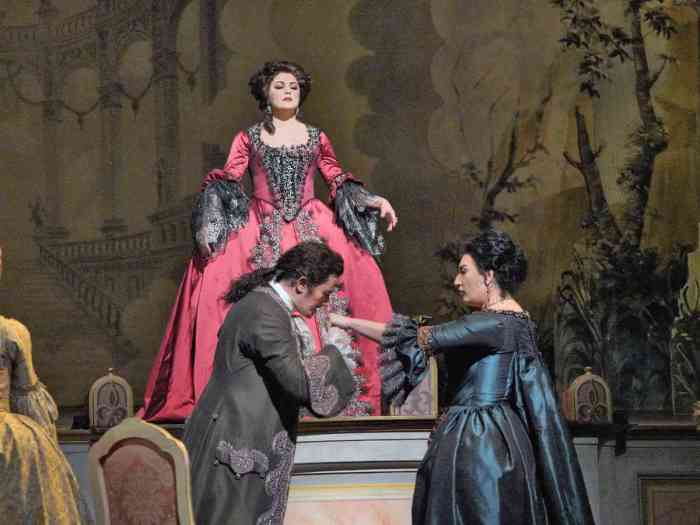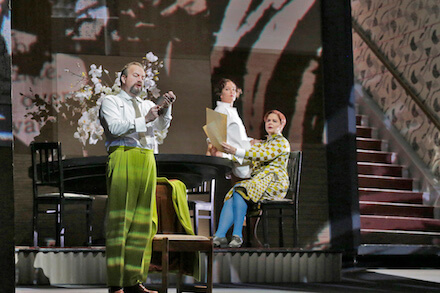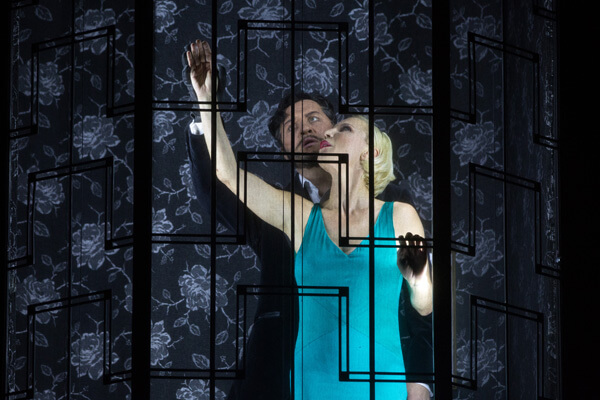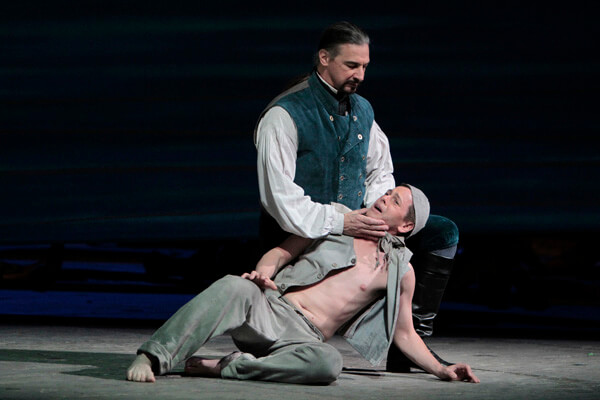Angess Nyama and Clayton Brown in Manhattan School of Music’s production of “A Little Night Music.” | BRIAN HATTON
My last Met show this season was Verdi’s “Un ballo in maschera,” very well conducted by veteran James Levine two days after he did an equally impressive “Rake’s Progress.” Perhaps these days it’s best to skip the opening night of a Levine revival; things seem to gel much more by the second show. The “Ballo” utilized David Alden’s visually ambitious and partially successful production; its good qualities — willingness to pose large questions about the characters, arrestingly era-jumping sets and costumes — get muted by some perversely undergraduate-level ideas. Would Gustavo really be prompted to reward a naval officer he witnesses drunkenly whoring? Must the two not very distinguished basses, in roles once sung by international stars, comport themselves like hammy caricatures of cartoon evil?
Piotr Beczala, who had been ill, tended toward steady mezzo-forte dynamics, but brought genuine charisma to the role, and it’s always a pleasure to hear his beautiful, stylishly used (if not exactly italianate) tenor. Sondra Radvanovsky’s unique sound divides opinion: despite some scooped attacks, much of what she did here was thrilling — vocally generous, dynamically varied, and technically adept in places, like the killer Act Two trio, where few Amelias living or dead could equal her. That said, one always wants more specific and cleanly articulated verbal phrasing. Without it, the character remains generalized, impressive rather than touching.
Verdi, Sondheim, Grétry, Honegger around town
Alexei Markov, singing his first Met Renato, sang handsomely, with real Verdian sound until he forced it at climaxes. With more restraint and more incisive words, he could cut a major swath through this repertory. Dolora Zajick (Ulrica) displayed remarkable endurance and clarity at register extremes; her middle voice has lost in impact, though not in steadiness. She deserved the crowd’s accolades. Heidi Stober, if lacking the precision in staccati of a Roberta Peters or Gail Robinson, was far less annoying dramatically than many Oscars. To me, hers is a rather anonymous timbre, and she too has a comparatively weak middle voice, so that she didn’t dominate ensembles where necessary. In sum, quite a strong cast, very well-mustered by Levine, made for a fun evening in this colossally tuneful score.
When Manhattan School of Music announced “A Little Night Music,” I was rather dubious — Sondheim’s marvelous work demands absolute dexterity, and Hugh Wheeler’s Ingmar Bergman-based book is a pseudo-elegant confection requiring great professionalism to paper over its lapses — like the witless joke at the expense of Ibsen’s “The Wild Duck,” which one can safely guess few, onstage or off May 13 have ever seen or read. Yet the evening proved quite delightful.
Carolyn Marlow’s fluid direction avoided many pitfalls, and the design team, especially Shawn Kaufman (sets) and Summer Lee Jack (costumes), evoked a handsome world. Shane Schag led a well-cast, musically cogent performance that proved very enjoyable except for one thing — sound design that from the first bars distorted voices and balance. Granted, Broadway today is way overamplified; but shouldn’t good conservatory vocalists in a smaller hall be learning really to sing unmiked?
In all other ways, the show was well timed to celebrate the news that MSM is establishing New York’s first-ever degree program in musical theater. All four romantic principals offered well-sung and compelling portraits. Agness Nyama’s Désiree was lovely to see and hear. She brought off “Send in the Clowns” very satisfyingly, though I think the post-Catherine Zeta-Jones default choice to cry through the wistful song’s last verse is a mistake. Baritone Clayton Brown really understands musical theater style — though youthful, he suggested Egerman middle-aged effectively. Nickolas Miller, though not the textbook basketball height Carl-Magnuses have been since Laurence Guittard originated the part, was duly handsome and arrogant, singing with some depth. Addie Hamilton’s delightfully acid Charlotte was as much a bulls-eye as her appealing Pamina on the same stage mere weeks before. She’s clearly a performer of range and vocal gifts.
Catherine Malfitano, an MSM grad, faculty member, and a star presence, sang with commendable clarity as Mme. Armfeldt. Dialogue was “homespun grandiose,” often slightly mistimed; she evoked Ann Miller playing Phoebe Tyler Wallingford. I never enjoy Anne and Henrik — since Hugh Wheeler’s book treats their pre-sexual juvenility with such utter contempt — but Samantha Williams and Luke Sikora embodied these ungrateful parts well. Viktoria Falcone sold “The Miller’s Son” with gusto and fine tone color, and Julia Suriano seemed ideal as Fredrika.
Ryan Brown’s Washington-based Opera Lafayette has become a welcome regular visitor to New York’s operatic scene. The troupe consistently illuminates neglected riches of the French baroque and classical canon. André Grétry’s four-hander-plus-chorus “L’épreuve villageoise” (1784) plumbs no depths — it was, in fact, the distillation of the comic parts of a longer, more serious work — but offered dialogue in Alexandrine verse in an intriguing Cajun setting, and proved pretty delightful to hear in Nick Olcott’s clever staging. May 27’s performance at Florence Gould Hall somewhat had the air of a final rehearsal, with some dropped lines and — due to humidity? — sagging string pitch, but the overall impression was strong. Two ideally cast francophone artists rather eclipsed — linguistically — mettlesome American soprano Talise Trevigne (Madame Hubert) and — vocally — Spanish tenor Francisco Fernández-Rueda (André). Thomas Dolié’s fine agility and legato served the elegant music of Monsieur de la France, and the baritone excels at playing pompous, sheep-headed comic foils. Canadian soprano Pascale Beaudin sang, danced, and acted the simple but savvy village maiden Denise with aplomb and sparkle — a real discovery, seeming a Patricia Petibon without the twee mannerisms. The company’s sense of ensemble as stylists, which extends to movement as well as musicianship, always pleases.
On June 11, the New York Philharmonic mounted Côme de Bellescize’s concerted and partially successful semi-staging of Arthur Honegger’s quirky oratorio “Jeanne d’Arc au Bûcher,” a celebration of the French national heroine that also critiqued the country’s political ethos before World War II. Honegger’s work lurches among modes and repeats key sections, so the narrative disconnects were not all de Bellescize’s fault. The strongest elements visually were by Thomas Costerg (lighting) and Colombe Lauriot Prevost (costumes).
New Yorkers, loving movie stars, cheered Marion Cotillard’s Joan to the echo. Her simple presence was inspiring and she spoke with musical feeling and point, but I wanted a bit more tonal and dynamic variety. Two Comédie-Française actors took part: Eric Genovese, a warm, beatific Dominique, and the hammier, if skilled, Christian Gonon, in multiple narrative and episodic tasks. The five vocal soloists were good, though bass Steven Humes needed coaching in French. Outstanding among them were the properly contrasted sopranos, the wonderfully soaring Erin Morley (Virgin Mary) and earthier Simone Osborne as one of Joan’s angelic voices.
Whether due to sound design or committed conductor Alan Gilbert miscalculating, the actors and singers sometimes receded behind the huge orchestra and fine multiple choruses.
David Shengold (shengold@yahoo.com) writes about opera for many venues.



































